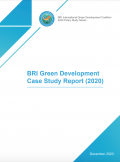This case study is based on the findings from the assessment of the Greater Banjul Project 2040. With the help of the Capacity Assessment Tool for Infrastructure (CAT-I), researchers identified the potential barriers to the planning, delivery, and management of sustainable infrastructure projects faced by the Gambian government. This study illustrates the first of the ten International Good Principles of Sustainable Infrastructure: Strategic Planning.
During the project, the research team managed to identify the potential technical, political, and economic challenges using the CAT-I tool. The CAT-I tool includes three stages of evaluation, consisting of 11 indicators and 90 sub-indicators, totaling approximately 900 yes/no questions used to assess the barriers for creation, implementation, and adaptation of sustainable infrastructure. The case study also highlights the importance of adapting international best practices within the local context, as well as the importance of input from local citizens in urban planning.
Guiding principle #1 Strategic Planning, from the International Good Practice Principles for Sustainable Infrastructure.




